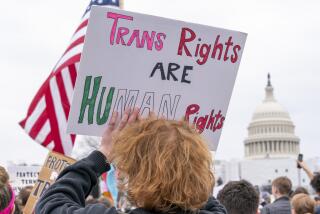Justices Rule U.S. Can Ban Medical Pot
- Share via
WASHINGTON — The Supreme Court on Monday upheld the federal government’s power to seize and destroy marijuana that is used as medicine by seriously ill patients, ruling that strict federal drug laws trump California’s liberalized policy on pot.
The Constitution makes the laws of the United States the “supreme law of the land,” and “if there is any conflict between federal and state law, federal law shall prevail,” Justice John Paul Stevens said for the court. It is up to Congress, he said, to change the law.
The 6-3 decision did not seek to resolve the dispute over whether marijuana may be good medicine. Instead, the justices focused on whether the federal government could enforce its zero-tolerance policy on marijuana in the 10 states -- most of them in the West -- where voters or lawmakers had opted to legalize marijuana used for medical purposes.
The court’s leading liberals sided with the Bush administration and its federal drug enforcers, while three of its more conservative members, including Chief Justice William H. Rehnquist, joined the side of the California marijuana users to limit federal authority.
The decision weakens, but does not overturn, state laws that permit seriously ill people to use marijuana to relieve pain or nausea.
Federal drug agents, prosecutors and judges may arrest, try and punish those who grow or use marijuana, the court said, even in states where it is legal.
However, state and local police need not assist in those efforts. And since most law enforcement is carried out by state and local officials, the liberalized medical marijuana laws should continue to have practical significance.
But California Atty. Gen. Bill Lockyer said the ruling showed “the vast philosophical difference between the federal government and Californians on the rights of patients.... Taking medicine on the recommendation of a doctor for a legitimate illness should not be a crime.”
Federal law enforcement officials sought to dispel the idea that drug agents would be unleashed on marijuana-using patients in California and other states.
“The vast majority of our cases are against those involved in trafficking, and major cultivation and distribution,” said Karen P. Tandy, head of the Drug Enforcement Administration. “I don’t see any significant changes in DEA enforcement strategies after today’s decision. We don’t target sick and dying people.”
However, the case before the court was brought by two ill California women, one of whom had her personal marijuana confiscated by federal agents.
Angel Raich, a brain tumor patient from Oakland, urged Congress on Monday to rethink its policy on marijuana.
“I’m in this battle, literally, for my life,” she said after the ruling. She called on Congress to “stop federal raids on sick and dying patients.... I hope for myself, for my children and for other patients out there that our congressional leaders put compassion first. Our lives are literally in their hands.”
A House bill is pending, sponsored by Rep. Barney Frank (D-Mass.), that would permit physicians to prescribe marijuana as medicine. But it has been rejected several times in the past, and its chances of becoming law are seen as slim.
In the Controlled Substances Act of 1970, Congress classified marijuana as a dangerous and illegal drug that had no benefits. Though many experts dispute that conclusion, Congress has made no move to amend the law. The statute makes it illegal to import, manufacture, distribute, possess or use marijuana.
But in 1996, California voters approved a measure that said “seriously ill Californians have the right to obtain and use marijuana for medical purposes” if they have a recommendation from a physician. Since then, Alaska, Colorado, Hawaii, Maine, Montana, Nevada, Oregon, Vermont and Washington have passed similar laws.
After the approval of those measures, cooperatives were set up to act as dispensaries for patients seeking marijuana. In 2001, however, the high court ruled that federal prosecutors could get court orders to shut down the operations.
The case decided Monday focused on patients who grew marijuana at home for their own use. It tested whether Congress’ power to regulate “commerce among the states” extended to individuals who were not buying or selling marijuana.
Raich sued to defend her use of marijuana as medicine. She suffers from serious medical conditions, including an inoperable brain tumor, chronic back pain and muscle spasms. She and her doctor said that cannabis was uniquely effective in relieving her pain. She sued along with Diane Monson after drug enforcement agents raided Monson’s Butte County home in 2002 and destroyed her marijuana plants.
Their lawyers argued that homegrown marijuana did not involve interstate commerce and therefore was beyond the authority of the federal government. They cited recent high court rulings that limited Congress’ power on other matters.
In the past, Rehnquist has said there was a crucial difference between national and local matters, and that the court should limit federal officials from meddling in local affairs. In 1995, for example, he spoke for a 5-4 majority that struck down the federal Gun-Free School Zones Act on the theory that gun possession was not commerce and therefore was beyond Congress’ authority to regulate.
The same is true of marijuana possession, Raich’s lawyers argued. They won in the U.S. 9th Circuit Court of Appeals in San Francisco two years ago. The “noncommercial cultivation and possession of cannabis for personal medical purposes” is beyond Congress’ power, the appeals courts said. It is “different in kind from drug trafficking.”
Then-U.S. Atty. Gen. John Ashcroft appealed to the Supreme Court. He argued that federal authorities could not eliminate the illegal national market in marijuana if it was legal to grow and possess the substance in 10 states.
The case posed an interesting twist for the justices. In the past, the liberals have favored broad federal power because it was crucial in areas such as the minimum wage law, civil rights enforcement and environmental protection. The conservatives have favored protection of states’ rights and limits on federal power.
In the case decided Monday, both sides were true to form but with two exceptions.
Justices Antonin Scalia and Anthony M. Kennedy, who in the past have taken the side of states’ rights, joined the court’s liberal bloc -- Justices Stevens, David H. Souter, Ruth Bader Ginsburg and Stephen G. Breyer -- in agreeing with the Bush administration’s stand against the marijuana users.
The six-member majority said Congress had the authority to police the nation’s illegal marijuana market.
“One need not have a degree in economics to understand why a nationwide exemption for the vast quantity of marijuana [or other drugs] locally cultivated for personal use ... may have a substantial impact on the interstate market for this extraordinarily popular substance,” Stevens wrote.
The court’s majority made clear it was not endorsing the federal policy on marijuana. “The voices of voters allied with [these two women] may one day be heard in the halls of Congress,” Stevens said.
Rehnquist and Justices Sandra Day O’Connor and Clarence Thomas dissented in Gonzales vs. Raich. They said the Constitution should be read to “protect historical spheres of state sovereignty from excessive federal encroachment.”
“This case exemplifies the role of states as laboratories,” O’Connor said. States’ voters and lawmakers, she said, should be given the freedom to set laws regarding “the health, safety and welfare of their citizens.”
Thomas questioned how a few patients could upset the national market for marijuana.
“Congress’ goal of thwarting the interstate drug trade would not plainly be thwarted if it could not apply the [federal law] to patients like Monson and Raich,” he said. “If Congress can regulate this ... then it can regulate virtually anything.”
*
(BEGIN TEXT OF INFOBOX)
Medical marijuana laws
The Supreme Court ruled that state laws did not protect patients from a federal ban on the use of marijuana.
States that allow patient use of marijuana with a doctor’s consent:
Alaska
California
Colorado
Hawaii
Maine
Montana
Nevada
Oregon
Vermont
Washington
--
Effective date of state’s medical marijuana law
Alaska: March 4, 1999
California: Nov. 6, 1996
Colorado: June 1, 2001
Hawaii: Dec. 28, 2001
Maine: Dec. 22, 1999
Montana: Nov. 2, 2004
Nevada: Oct. 1, 2001
Oregon: Dec. 3, 1998
Vermont: July 1, 2004
Washington: Nov. 3, 1998
--
Sources: National Organization for the Reform of Marijuana Laws, Associated Press
*
Times staff writer Richard B. Schmitt contributed to this report.
More to Read
Sign up for Essential California
The most important California stories and recommendations in your inbox every morning.
You may occasionally receive promotional content from the Los Angeles Times.











